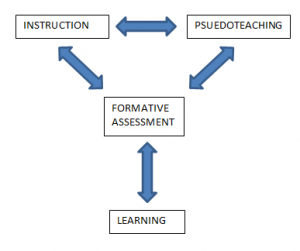Peer Instruction in a Wider Context
One thing that I’ve been thinking about lately is how peer instruction or other attempts to get away from pseudoteaching can be applied to junior science classes. For example, yesterday I started a Grade 8 science unit on Water. I really like this unit because it has a lot of relevance for the kids and a good number of opportunities for both lab inquiries and outdoor experiential trips. However, I can’t help think that the actual learning of the topics is firmly grounded in reading and scientific literacy. Labs aside, the teaching methods I have used include:
- me talking to the kids (teacher centered)
- me giving notes to the kids (teacher centered)
- have the kids read, talk, and do worksheets (pseudo-student centered)
- have the kids read and do projects (student centered)
I don’t mind the “me talking” as an introduction to a topic. I try to ask cunning questions (so cunning, you could pin a tail on it and call it a weasel) to actually stimulate dialogue but this can be pretty tough. The students quite often are not used to pushing the limits of what they are thinking about. If the students have a mindset of “repeat what I’ve been told that I’ve learned,” then their answers to open-ended questions can be very basic and short. Once a culture of inquiry and wondering is instilled, these opening dialogues would be more fruitful.
I also don’t mind the “me giving notes” part. The reason for this is linked to scientific literacy. The kids can mostly read the textbook (or whatever content provider they have) and even parse the material to answer worksheets. However, I think there can be a huge gulf between repeating knowledge and actual comprehension. Therefore I use “notes” as a way to present graphic organizers to the students. My “notes” will be graphic in nature, showing pictures and arrows which hopefully show some type of order or connection between topics and keywords. Often I will use specific tools such as 20 word GIST summaries, Venn Diagrams and Frayer Models. Once the students get used to these tools, the need for me to give “notes” diminishes.
The reason that I say that the “kids read, talk and do worksheets” is pseudo-student centered is because in this stage they are at the mercy of the content provider (usually a textbook). The students don’t really get a chance to choose how they get their information, and I think their analysis and evaluation of the material greatly depends on their level of critical thinking. All of this can be tied together nicely with an appropriate project, which finally gives the students more of a say in how their learning will progress.
As I stated at the start, I don’t know how something like peer instruction happens in this type of context. What I think would really fill in the gaps would be appropriate formative assessment and assessment for learning. By using intelligent assessment instruments and practices, we should be able to see where efforts should be focused and individualized for better understandings and success. So while I struggle with better instruction techniques, I hope that by using assessment for learning and targeting scientific literacy, that my students will be given a fighting chance to learn and hopefully even enjoy science class!

